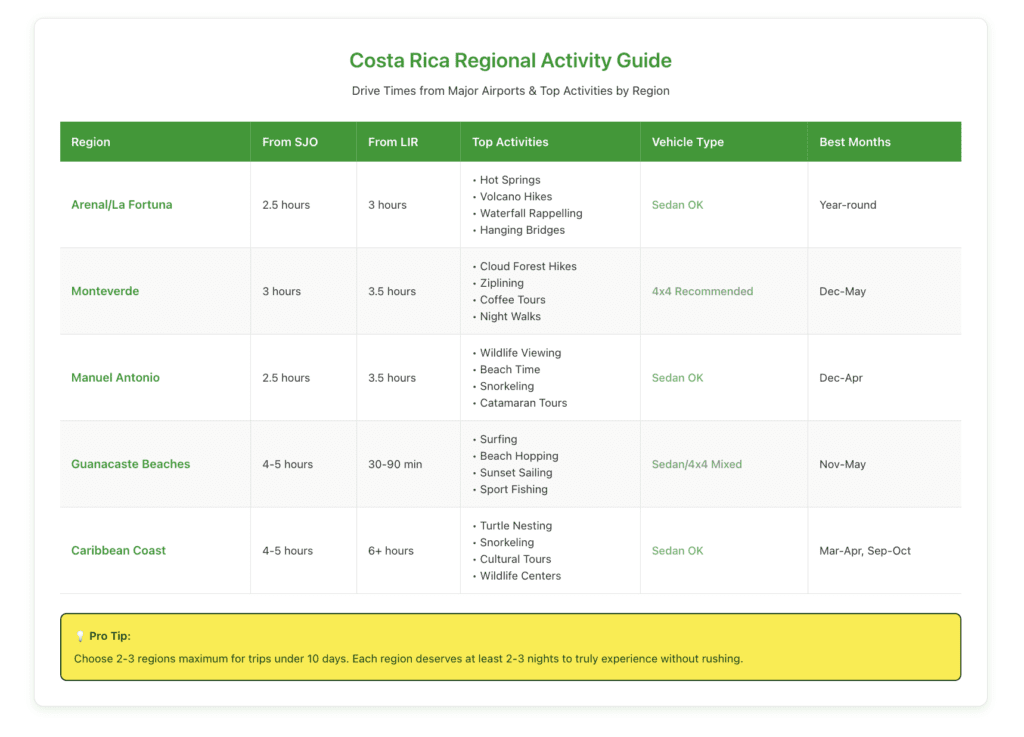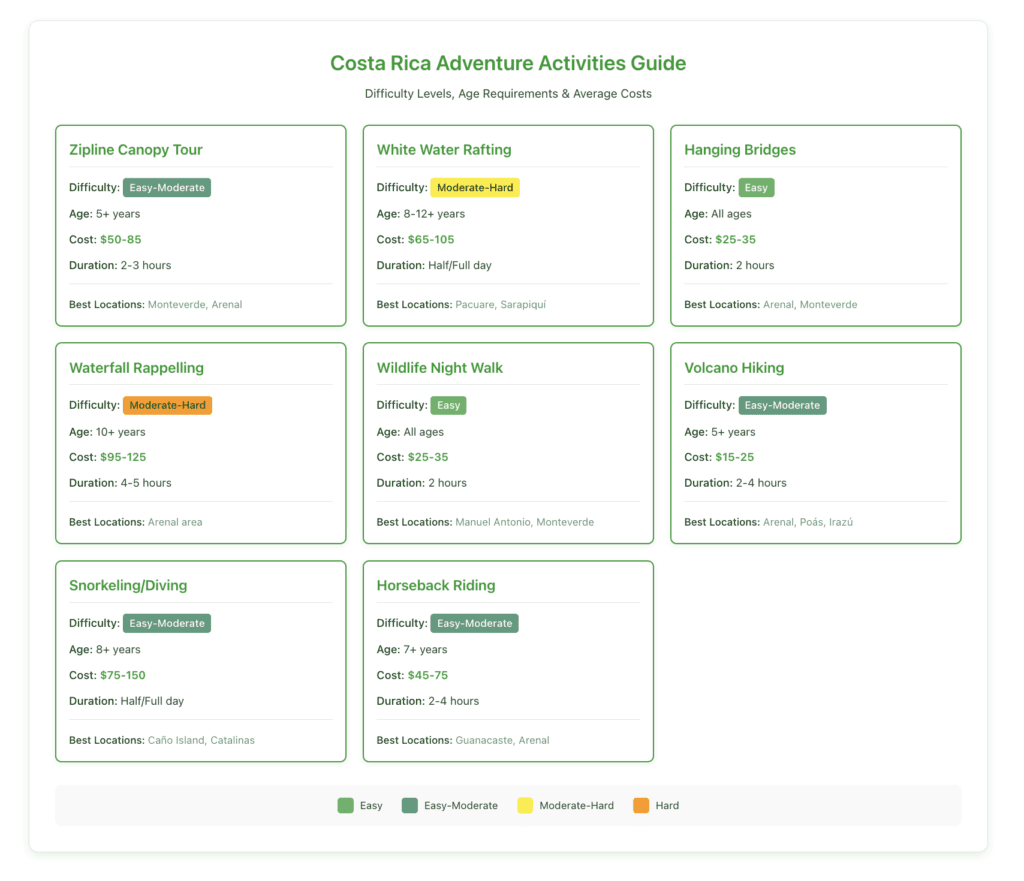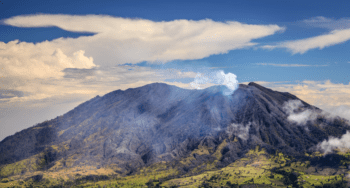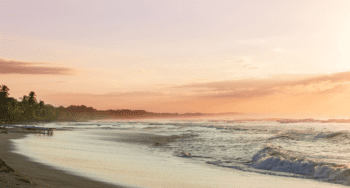Costa Rica Activities: What's Covered
Costa Rica’s best activities cluster in five main regions, each requiring 2-3 days minimum to experience properly. From Arenal’s hot springs and ziplines to Manuel Antonio’s wildlife encounters and Guanacaste’s adventure sports, planning around drive times and vehicle requirements makes the difference between rushed tourist stops and meaningful experiences. Morning starts before 7 AM mean cooler temperatures, active wildlife, and smaller crowds. A standard sedan handles 70% of destinations, while specific mountain and beach roads need 4×4 access.
Quick Facts:
- Budget $50-150 per person for most guided activities (multi-activity packages save 20-30%)
- Dry season (December-April) suits beaches and hiking; green season offers better wildlife viewing
- Most iconic spots are within 2-3 hours from SJO airport
- National parks charge $10-16 entrance; book Manuel Antonio 30 days ahead
- Sunday mornings and weekday green season visits avoid crowds
Top Activity Regions:
- Arenal/La Fortuna – 2.5 hours from SJO via Route 702. Hot springs, volcano hikes, and adventure activities all within 30 minutes of each other.
- Manuel Antonio – Beach and wildlife combo 2.5 hours from SJO via Route 27 toll road. Four hiking trails plus swimming with monkeys overhead.
- Monteverde Cloud Forest – Zipline birthplace requiring 4×4 for final 30km. February-July quetzal nesting makes morning guided walks essential.
- Guanacaste Province – From Tamarindo base, reach 15+ activities within 90 minutes from Liberia Airport.
- Central Pacific – Perfect for shorter trips with Carara National Park and Playa Hermosa just 1 hour from SJO.
Having your own transportation from Vamos transforms rigid tour schedules into genuine exploration – that waterfall mentioned by your hotel’s gardener becomes an afternoon adventure instead of a missed opportunity.
If you need any help with a Costa Rica car rental, contact us now!
Costa Rica packs more biodiversity, adventure, and culture into 51,000 square kilometers than seems physically possible. After helping thousands of travelers navigate this incredible country, we’ve learned that the difference between a good Costa Rica trip and an unforgettable one comes down to knowing which experiences are worth your time, how to reach them efficiently, and when each activity shines brightest. Whether you’re chasing adrenaline on ziplines, seeking wildlife in cloud forests, or soaking in volcano-heated hot springs, understanding the practical details—drive times, vehicle requirements, and seasonal considerations—transforms overwhelming options into an achievable adventure.
Key Takeaways
- Most iconic activities cluster in 5 main regions, each requiring 2-3 days minimum.
- A standard sedan handles 70% of destinations; only specific mountain and beach access roads need 4×4.
- Dry season (December-April) suits beach and hiking activities; green season (May-November) offers better wildlife viewing and fewer crowds.
- Budget $50-150 per person for most guided activities, with multi-activity packages offering 20-30% savings.
- Morning starts (before 7 AM) provide cooler temperatures, active wildlife, and smaller crowds at popular spots.

Which Activities Define the Essential Costa Rica Experience?
What Makes Arenal Volcano & La Fortuna Unmissable?
Arenal’s perfect cone shape rising 1,670 meters above the northern plains creates Costa Rica’s most photographed landmark, but the real magic happens at ground level. The 2.5-hour drive from SJO airport via Route 702 brings you to a geothermal wonderland where naturally heated rivers create tiered hot spring pools with volcano views.
Morning hikes through Arenal National Park’s Coladas Trail reveal 1968 lava flows now colonized by orchids and bromeliads. The trail’s moderate 3.5km loop takes about 2 hours, opening to Lake Arenal views that photographers dream about. Entry costs $15, and arriving before 8 AM means cooler hiking conditions plus howler monkey wake-up calls echoing across the canopy.
The famous Tabacon Hot Springs justify their $98 entrance fee with manicured gardens and swim-up bars, but locals know about the free hot springs along the Tabacon River. Park at the bridge 1km past the resort entrance (look for other cars), then follow the trail down to the natural pools. Evening soaks here, especially during full moon, create memories that outlast any resort experience.
Why Do Wildlife Enthusiasts Obsess Over Manuel Antonio?
Manuel Antonio National Park compresses Costa Rica’s biodiversity into just 683 hectares, creating wildlife encounters so reliable that even first-time visitors leave with frame-worthy sloth selfies. The 2.5-hour drive from SJO via Route 27 (toll road, about $8 total) delivers you to the country’s most accessible wildlife watching.
The park’s four trails range from wheelchair-accessible boardwalks to the challenging Punta Catedral loop. Morning entries at 7 AM (book online 30 days ahead for $16) guarantee sloth sightings—guides know exactly which cecropia trees host rotating sloth families. White-faced capuchin monkeys have learned to unzip backpacks, so they use the free lockers at the entrance.
Beach access within the park provides the unique experience of swimming while monkeys play overhead. Playa Espadilla Sur’s calm waters suit families, while Playa Manuel Antonio’s coral formations offer decent snorkeling. Bring reef-safe sunscreen—regular versions face $100 fines, and rangers check.

Where Should Adventure Seekers Focus Their Energy?
Which Zipline Experiences Rise Above Tourist Traps?
Costa Rica invented modern zipline canopy tours, and Monteverde’s cloud forest setting remains the gold standard. The 3-hour drive from SJO requires a 4×4 for the final 30km of mixed dirt/gravel roads, though many visitors park in Santa Elena and use hotel shuttles for the bumpy final stretch.
Selvatura’s course features 15 cables totaling 4km, including the 1km “Superman” cable, where you fly face-first at 60kph. Their $50 price includes hanging bridge access, making it an excellent value. Book the 8 AM slot—morning mist creates ethereal forest views, and you’ll zip above the canopy before crowds arrive.
Sky Adventures offers the extreme option with their “Sky Limit” challenge, combining ziplines, rappelling, and a Tarzan swing. At $84, it’s pricier but includes transportation from area hotels. The final platform sits 200 meters high, offering Pacific Ocean views on clear days.
What Rafting Rivers Deliver World-Class Rapids?
The Pacuare River consistently ranks among the world’s top 5 rafting destinations, combining Class III-IV rapids with pristine rainforest scenery. The put-in point lies 2 hours from SJO via Turrialba, though most operators include round-trip transportation in their $95-105 packages.
December through May offers the most consistent water levels, with March-April providing the perfect balance of exciting rapids and clear weather. The standard day trip covers 28km in about 4 hours of river time, passing waterfalls and indigenous Cabécar villages accessible only by river.
The Sarapiquí River provides a mellower alternative suitable for ages 8+, with Class II-III rapids perfect for families. Located 1.5 hours from SJO via Heredia, half-day trips cost around $65 including lunch. July through November brings higher water levels here, creating more exciting runs during the green season when other activities might face weather challenges.

Which Natural Wonders Justify Long Drive Times?
Why Do Photographers Dream About Rio Celeste?
Rio Celeste’s impossibly blue waters result from volcanic minerals creating an optical illusion that cameras struggle to capture accurately. The 3-hour drive from Liberia Airport (2 hours from La Fortuna) via mostly paved roads leads to Tenorio Volcano National Park’s entrance.
The 6km round-trip hike descends 300 meters through primary rainforest to reach the waterfall. Recent improvements added 253 steps with handrails, making the descent safer during rain. The trail continues to “Los Teñideros,” where two clear rivers merge and mysteriously turn bright blue. Budget 3-4 hours total, bringing rain gear year-round—the forest creates its own weather system.
Admission costs $12, and the park limits daily visitors to preserve trail conditions. Arrive before 8 AM or after 2 PM to avoid tour groups. The nearby Bijagua area offers the free “Teñideros del Rio Celeste” swimming hole, where locals enjoy the blue waters without hiking. Find it 2km past Bijagua heading toward the park—look for cars parked along the road.
What Makes Monteverde Cloud Forest Extraordinary?
Monteverde’s cloud forests exist because Pacific and Caribbean weather systems collide at the continental divide, creating perpetual mist that supports 2.5% of global biodiversity. The journey from SJO takes 3 hours via the Sardinal route (mostly paved) or 2.5 hours via Guacimal (requires 4×4 for steep sections).
The Monteverde Reserve’s 13km trail system ranges from easy 30-minute loops to challenging full-day hikes. The Sendero Bosque Nuboso trail offers the best quetzal spotting from February through July during nesting season. Early morning guided walks ($25 plus $25 entrance) significantly increase wildlife sightings—guides carry telescopes and know where different species feed.
Santa Elena Reserve receives fewer visitors despite equally impressive biodiversity. Their Caño Negro trail leads to a 30-meter observation tower above the canopy, offering views of Arenal Volcano on clear days. At $16 entrance versus Monteverde’s $25, it provides better value for independent hikers.

How Do Seasonal Changes Affect Activity Planning?
Which Experiences Improve During the Green Season?
May through November’s afternoon rains transform Costa Rica into an emerald paradise with significant advantages for certain activities. Whitewater rafting reaches peak excitement as rivers swell—the Pacuare’s rapids upgrade by half a class, creating heart-pounding runs that experienced rafters prefer.
Wildlife viewing improves dramatically as animals concentrate around remaining water sources. Corcovado National Park, typically requiring 3-4 days minimum commitment, becomes particularly rewarding. The 8-hour journey from SJO (fly to Drake Bay for $150 or drive to Sierpe, then boat) pays off with jaguar sightings increasing 300% during September-November when turtle nesting attracts predators.
Hot springs feel even more magical during rain showers. Tabacon and other Arenal-area springs stay open during storms, and soaking in thermal waters while rain patters on tropical leaves creates an almost spiritual experience. Afternoon rains rarely start before 2 PM, leaving mornings clear for activities.
When Does Dry Season Truly Matter?
December through April’s reliable sunshine enables certain experiences impossible during the green season. The Nicoya Peninsula’s dirt roads become accessible to regular vehicles, opening up beaches like Playa Barrigona and Playa Guiones that turn into muddy challenges when wet.
Volcano crater visibility peaks during dry season mornings. Poás Volcano (1 hour from SJO) and Irazú Volcano (1.5 hours from SJO) are often clouded over by 10 AM year-round, but the dry season provides more viewing days. Both charge $15 entrance fee and require advance reservations through the SINAC website.
Snorkeling and diving visibility improves dramatically. Caño Island’s waters are clear to 30-meter visibility from December through April, justifying the journey from Sierpe (45-minute boat ride) or Uvita (90-minute boat ride). Full-day trips, including snorkeling at two sites, cost $75-95, with dolphins frequently joining boats.
Which Regions Offer the Most Efficient Activity Clusters?
How Can You Maximize Guanacaste Province Adventures?
Guanacaste’s dry forest ecosystem and developed tourism infrastructure create Costa Rica’s most activity-dense region. From Tamarindo as a base, you reach 15+ major activities within 90 minutes, eliminating constant hotel changes.
Rincon de la Vieja National Park (1 hour from Liberia Airport) combines volcanic features with adventure activities. The Las Pailas trail passes bubbling mud pots and steam vents in 3.5km, while nearby Hacienda Guachipelin offers ziplining, horseback riding, and river tubing in single-day packages ($85-120).
Palo Verde National Park’s boat safaris guarantee wildlife sightings impossible elsewhere. The 2-hour drive from Tamarindo via Puente La Amistad leads to wetlands hosting 300 bird species plus crocodiles, monkeys, and iguanas. Morning boats ($35) between December and March coincide with migratory birds, creating photography opportunities that fill memory cards.
Why Does the Central Pacific Suit Time-Limited Visitors?
The Central Pacific’s proximity to SJO airport makes it perfect for shorter trips. Using Jacó or Manuel Antonio as bases, you access beaches, national parks, and adventure activities without long transfers eating into vacation time.
Carara National Park bridges tropical dry and humid forests, just 1 hour from SJO via Route 27. The Universal Access Trail’s 1.2km boardwalk guarantees scarlet macaw sightings as pairs fly between feeding areas morning and evening. The $10 entrance fee includes access to longer trails where birding guides report 400+ species.
Crocodile Bridge (officially Tárcoles Bridge) offers Costa Rica’s easiest megafauna viewing. Located on Route 27 between SJO and Jacó, the bridge spans the Tárcoles River where 20+ American crocodiles, some exceeding 5 meters, bask below. Early morning visits avoid tour bus crowds, and the south side offers safer photo angles.

What Hidden Experiences Do Locals Guard Jealously?
Where Do Ticos Actually Spend Weekends?
Costa Ricans escape tourist crowds at Bajos del Toro, a mountain village 2 hours from SJO via Sarchí. The area’s three major waterfalls—Catarata del Toro, Blue Falls, and Tesoro Escondido—see mostly local visitors despite rivaling famous falls elsewhere.
Catarata del Toro plunges 90 meters into an extinct volcanic crater. The private reserve charges $17 but includes maintained trails that make the steep descent manageable. Their early bird special (7-9 AM) reduces admission to $12 and guarantees you’ll share the viewpoint with only hummingbirds.
The Saturday farmers’ market in Ciudad Quesada (San Carlos) showcases real Costa Rican life. Located 2 hours from SJO via Route 141, the market explodes with tropical fruits, artisan cheeses, and prepared foods you won’t find in tourist areas. Try “agua de sapo” (toad water)—a ginger and brown sugar drink that locals swear prevents everything from colds to hangovers.
Which Off-Radar Beaches Reward Adventurous Drivers?
Playa Barrigona near Sámara requires 4×4 for the final 3km but rewards effort with pristine sand framed by 50-meter trees. Low tide reveals tide pools packed with tropical fish, while the river mouth attracts white-faced monkeys at dawn and dusk. No facilities exist, so pack everything, including shade.
Playa Quesera on the Nicoya Peninsula stays empty because reaching it requires local knowledge. From Nosara, drive toward Esperanza, turn at the second dirt road after the soccer field, then follow the track 4km to the beach. The left point breaks perfectly at mid-tide, while the right side’s calm water suits swimming.
How Much Should You Budget for Costa Rica Activities?
What Are Realistic Daily Activity Costs?
Budget $100-150 per person daily for organized activities, though smart planning reduces costs significantly. National park entrances average $10-16, while guided tours range from $45 for hiking to $125 for premium adventures, including equipment and lunch.
Multi-activity packages from established operators save 20-30% versus booking separately. A typical Arenal combo, including hanging bridges, waterfall rappelling, and hot springs, costs $135 versus $180 when purchased individually. Monteverde’s parks offer similar bundles combining ziplines, coffee tours, and night walks.
Transportation often doubles activity costs. Manuel Antonio National Park charges just $16 entrance fee, but round-trip shuttles from area hotels add $20-30. Renting a vehicle for $45 daily suddenly makes economic sense for groups, plus provides flexibility to explore the surrounding areas.
Which Free Activities Rival Paid Attractions?
Every Sunday, San José’s Avenida Central becomes pedestrian-only from Plaza de la Cultura to Parque Morazán. Street performers, artisan vendors, and food stalls create a festival atmosphere that captures urban Tico culture better than any museum.
The hills above Atenas hide dozens of coffee farms welcoming visitors during harvest season (November-February). Drive Route 3 toward Grecia, stopping at farms with “café” signs. Most offer free tastings and impromptu tours, selling roasted beans at half tourist prices.
Playa Hermosa near Jacó provides world-class surf watching absolutely free. The beach’s consistent waves host international competitions, and the rocky point at the north end offers stadium seating for spectacular wipeouts and victories. Friday afternoons bring local surfers throwing aerials that rival any professional show.
When Should Each Activity Take Priority?
How Do You Structure the Perfect First Visit?
First-time visitors should prioritize Costa Rica’s “greatest hits”—experiences that define the country’s character. Allocate 3 nights in Arenal for volcano views, hot springs, and one adventure activity. Add 2 nights in either Monteverde (cloud forest) or Manuel Antonio (beach and wildlife), depending on preferences.
This 5-night foundation leaves room for day trips or extending stays. From Arenal, Rio Celeste makes an excellent day excursion. From Manuel Antonio, Carara National Park adds serious birding. From Monteverde, the boat-vehicle-boat crossing to Arenal provides memorable transportation, doubling as sightseeing.
Avoid cramming too many destinations. The “been everywhere, seen nothing” approach plagues Costa Rica itineraries. Three hours represents the maximum enjoyable daily drive—beyond that, you’re spending vacation time in a vehicle from Vamos instead of experiencing the country.
Which Activities Match Different Travel Styles?
Family trips with young children thrive on wildlife experiences requiring minimal physical effort. Manuel Antonio’s beaches, Arenal’s gentle trails, and boat safaris in Palo Verde deliver excitement without exhausting parents. The Jaguar Rescue Center near Puerto Viejo offers guaranteed animal encounters in controlled settings.
Adventure seekers should cluster activities efficiently. Spend 3-4 days in Arenal combining canyoning, white-water rafting, and challenging hikes. Move to Monteverde for ziplines and cloud forest exploration. This focused approach provides adrenaline without constant hotel changes.
Relaxation-focused visitors find their rhythm on the Nicoya Peninsula. Base in Nosara or Sámara, alternating beach days with gentle activities like stand-up paddleboarding, sunset horseback rides, or yoga. The 4-hour drive from LIR feels worthwhile when you’re staying put for a week.

What Practical Details Make or Break Experiences?
How Do Road Conditions Affect Activity Access?
Understanding road conditions prevents frustration and potentially dangerous situations. Google Maps often suggests routes that become impassable during rain or require serious 4×4 capabilities. Always verify current conditions with locals or your accommodation.
The Monteverde road from Tilaran remains rough despite improvements, with 15km of rutted dirt requiring 90 minutes to navigate safely. The Sardinal route stays paved longer but includes steep grades that challenge underpowered vehicles. Either route becomes significantly more challenging after 3 PM rains begin.
Beach access roads vary wildly even within the same region. Tamarindo’s paved streets contrast sharply with nearby Playa Grande’s soft sand tracks that trap 2WD vehicles at high tide. Research specific beach access before committing, or park on solid ground and walk the final stretch.
What Safety Considerations Often Get Overlooked?
Ocean conditions change dramatically between beaches and seasons. Tamarindo’s consistent waves suit beginners, while Playa Hermosa’s powerful shore break injures experienced surfers. Check current conditions at each beach—local surf shops provide honest assessments that hotel concierges might sugarcoat.
Wildlife viewing requires respecting animals’ space and power. Maintain 3 meters from monkeys and 15 meters from cats or tapirs. Capuchin monkeys in Manuel Antonio have learned to raid bags but will back off from confident humans who don’t run. Never feed any wildlife—it creates dangerous dependencies and aggression.
Adventure activity operators vary wildly in safety standards. Legitimate zipline operations display ICT (Costa Rica Tourism Board) certification and insurance documentation. Guides should speak clear English and demonstrate equipment use before starting. If anything feels sketchy, trust your instincts and leave.
How Does Renting a Vehicle Transform Your Options?
The freedom to stop for roadside fruit stands, chase perfect sunset spots, and leave when crowds arrive transforms Costa Rica from a series of scheduled tours into genuine exploration. With your own wheels from Vamos Rent-A-Car, that waterfall mentioned by your hotel’s gardener becomes an afternoon adventure instead of a missed opportunity.
GPS helps navigate main routes, but download offline maps before leaving wifi—cellular data disappears between towns. Waze works better than Google Maps for real-time hazard warnings, as locals actively report police checkpoints, accidents, and road damage.
A sedan from Vamos handles coastal areas, the Central Valley, and main tourist corridors connecting Arenal, Monteverde via paved routes, and Manuel Antonio. These destinations represent 70% of visitor itineraries. The 4×4 becomes necessary for certain beaches, mountain lodges, and wet season exploration when afternoon rains turn dirt roads into slip-and-slides.

Frequently Asked Questions
What’s the minimum time needed to experience Costa Rica properly?
Seven nights allows visiting two regions thoroughly, while 10-14 nights enables the classic triangle of Arenal, Monteverde, and a beach destination. Shorter trips should focus on the Central Pacific or Arenal alone rather than rushed multi-destination sprints.
Do I really need to book activities in advance?
Popular experiences like Manuel Antonio National Park, Monteverde reserve morning entries, and multi-day Corcovado treks require advance booking, especially December through April. Most day activities accommodate walk-ins during the green season, though morning time slots always fill first.
Which activities are actually worth the premium prices?
Night wildlife walks with quality guides, multi-day rafting trips on the Pacuare, and permitted Corcovado hiking justify higher costs through exclusive access or expertise. Generic zipline tours and tourist-trap “chocolate tours” rarely merit premium pricing—seek operator-run versions at half cost.
How do I avoid the crowds at popular attractions?
Start before tour buses arrive (usually 9 AM) or visit during the afternoon rain predictions scare off groups. Sunday mornings see fewer visitors as many Costa Ricans attend church. Green season weekdays provide popular parks practically to yourself.
Is it safe to drive myself to remote activities?
Daytime driving to established attractions poses no special risks beyond road conditions. Avoid driving after dark when possible—not for crime but because roads lack lighting, and animals frequently cross. Keep windows up in downtown areas and never leave anything visible in parked vehicles.
What’s the deal with different prices for locals versus tourists?
Dual pricing exists at many attractions, with Costa Ricans paying 50-70% less. Some operators honor residency cards or student IDs for discounts. Private reserves and tour operators typically charge everyone equally, while government-run parks maintain official two-tier pricing.
Should I book tours from home or locally?
Book must-do experiences and peak season activities from home for peace of mind. Leave flexibility for weather-dependent activities and spontaneous discoveries. Local booking often provides 10-20% savings and allows weather-based decisions, particularly for boat trips and mountain activities.
Which regions require more physical fitness?
Corcovado and Chirripó demand serious hiking fitness. Monteverde’s cloud forest trails range from flat boardwalks to steep, muddy challenges. Most beaches, Arenal’s main trails, and boat-based activities accommodate various fitness levels with options to match capability.




